Native Plant Species Articles
Local Haunts
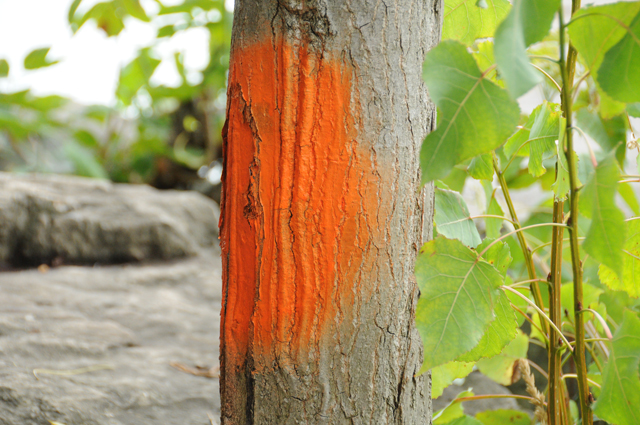
Given the frighteningly eventful year, I’m inclined to be less than thrilled with the typical contrived Hallowe’en decorations and antics. I wonder if there’s an equivalent to Scrooge’s "Bah Humbug!"?
Hallowe’en trappings which we normally see and are meant to frighten, pale in comparison to their surroundings. The real scary stuff lies unnoticed or undetected to the casual eye. I see a chilling scene available all year unless the snow cover does its job. In my local haunts, I see everything from invasive species to paved over greenspaces. And forgive me for thinking trees, especially, must have a target on them. Now that’s scary! Read more
Tree Debris (Pt. II)
 Typical streetscape weeks after the ice storm.
Typical streetscape weeks after the ice storm.
Tree Debris (Pt. I) covered some of the devastation as a result of a widespread ice storm that engulfed the Greater Toronto Area in December 2013. Imagine the city canopy as an open canopy; dysfunctional forest; forcing trees into artificial design (construct) and expecting them to behave as if they are in a confined area (forest) which would produce a closed canopy; but we've released the pressure to stay confined by planting them on road edges or in the open without others around.
Read more
The Following articles were originally published on the Native Plants and Wildlife Gardens website.
Tree Debris (Pt. I)
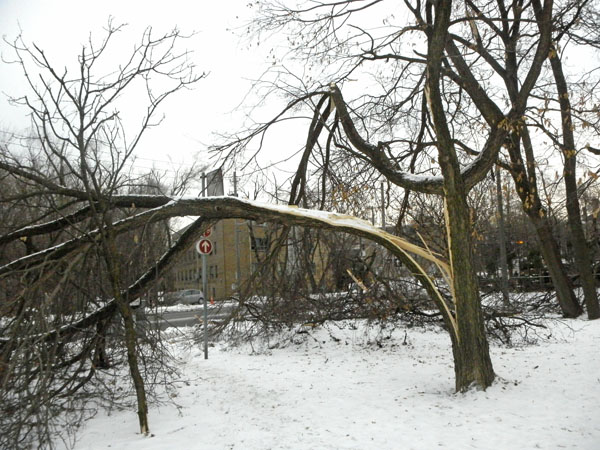 This way up. Hackberry (Celtis occidentalis) lives up to its name.
This way up. Hackberry (Celtis occidentalis) lives up to its name.
Tree Debris (Pt. I) In the wake of the ice storm of December 2013, it was reported that Toronto lost about 20% of its tree canopy. That was the figure that was bandied about, yet it might as well have been pulled from the same thin, wintery air we've been breathing up here for what seems like eternity. It will be many more months, if not years, before we get a handle on how devastating the ice storm was to our green infrastructure.
Read more
Winter Wallop
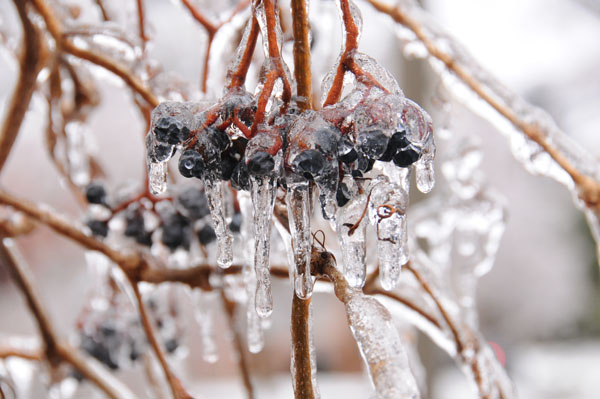 Ice-encrusted Virginia creeper (Parthenocissus quinquefolia).
Ice-encrusted Virginia creeper (Parthenocissus quinquefolia).
We were warned. We knew it was coming. The winter solstice fell on December 21, 2013. And then winter welcomed us with a wallop in the form of an ice storm of unprecedented magnitude not seen in this area in recorded history. Ice storms are rare in southern Ontario. Two to four hours of freezing rain at a time, mounting to 17 hours of freezing rain over several days is an example of a typical ice storm. But forty hours plus of freezing rain in one big event? It sounds dramatic.
Read moreDirt to Turf
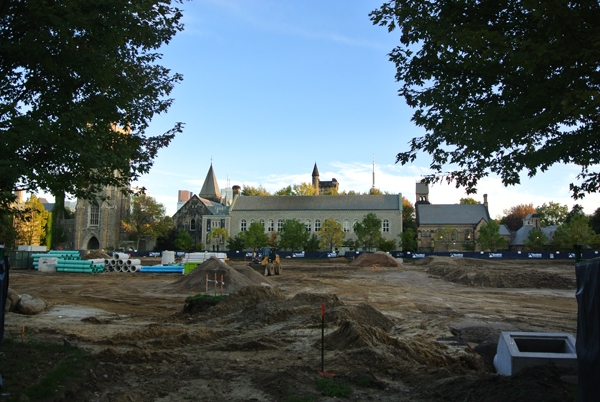 U of T - The Back Campus field.
U of T - The Back Campus field.
This past summer (2013), it was with heavy heart I said goodbye to another green space in Toronto – The Back Campus field at the University of Toronto, where I studied and now work. It was a pastoral setting amongst heritage buildings and old English elms. It was an integral part of the university commons.
Read moreCarole Sevilla Brown and her Award Winning Style
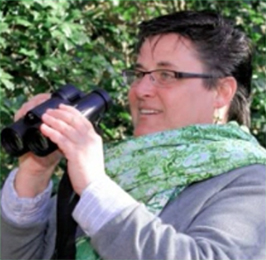 Carole Sevilla Brown
Carole Sevilla Brown
Bring it on! Last Saturday, I was asked to introduce one of two Conservation Awards given out at the
North American Native Plant Society's Annual General Meeting. Our own
Carole Sevilla Brown was a recipient of this award because she embraces native ecosystems and their place in our gardens.
Read moreThe Lawn Locked Yard
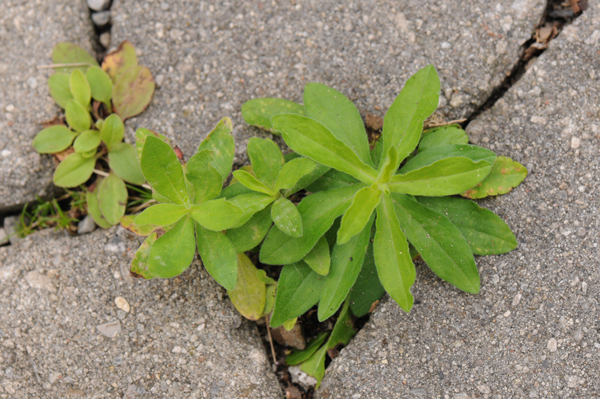 A couple of lawn lost friends: New England aster (Symphyotrichum novae-angliae).
A couple of lawn lost friends: New England aster (Symphyotrichum novae-angliae).
Something didn't feel right this spring of 2013. It was funky weather; rainy and cool. I didn't feel in the mood to grow vegetables as I have done since moving into the house in 2003. I was feeling pissy, just like the weather. The pile of frustrations of too much work and not enough time to do everything that I needed or wanted to do was making me harried. The thought of the task ahead to shop for plants and maintain a veggie garden was too daunting.
Read moreMy Roadside Garden
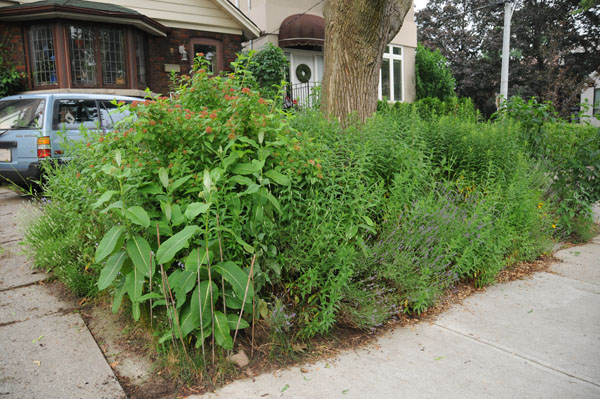 It's a jungle in there! Full frontal view, Spring 2013.
It's a jungle in there! Full frontal view, Spring 2013.
What is that? What is a North American garden? It's not an English garden, European garden or Japanese garden. Although, it doesn't mean that it can't look like one of these types, but with the use of native species. I've seen cold-hardy, honey locust pruned to look like acacia trees in the African Savannah of the Toronto Zoo.
Read moreHellish Heliopsis
 Does this look like the face of a bully?
Does this look like the face of a bully?
The ABC set of descriptors are synonymous with invasive species. Invasive species are very successful exotics, i.e., colonizers that have been for the most part released of what keeps them in check. They are damaging to the environment. But the ABCs could also be easily ascribed to a number of native species, too. And it is those species that we have to be careful about when gardening, particularly in a small garden on the boulevard. It really pays to research what you introduce and invite to stay as a resident in your garden.
Read moreNorway maple – I'm stuck with you
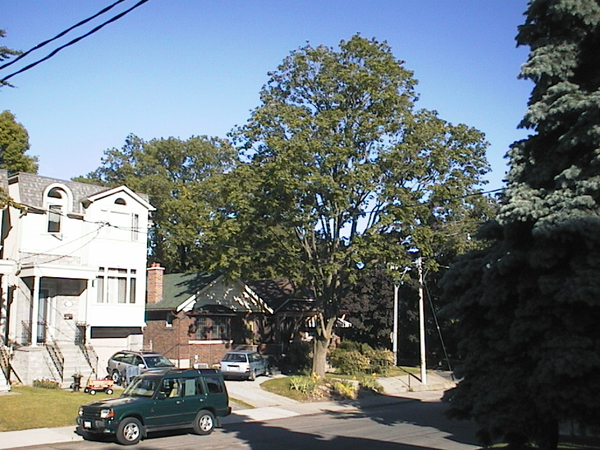 Norway maple
Norway maple
I'm conflicted. Everything about the Norway maple (Acer platanoides) points to it being a blight on the landscape. It's invasive; taking over our ravines and crowding out native species. It is not a multi-purpose tree. True – it gives shade, produces oxygen, filters the air, and mitigates stormwater. But, it doesn't host any insect parties. From what I've seen, it's only good for aphids and tar spot fungus (
Rhytisma acerinum).
Read moreCity Living – Right of Passage
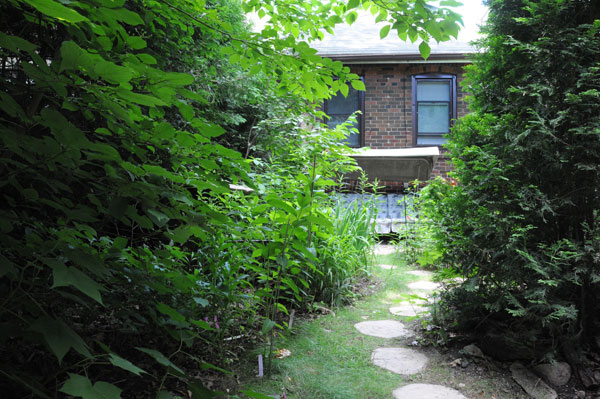 Safe wildlife passage
Safe wildlife passage
There has always been an age-old issue of conflicts between humans and wildlife; us against them. In the past, we got rid of the "problem” swiftly but with little thought as to the long term consequences. Now, we have expanded and concentrated our population to the point that we are noticing the impacts. We have realized that resources are finite and we have to take into consideration the other surviving inhabitants around us who also rely on the same resources.
Read moreCity Living – adapt!
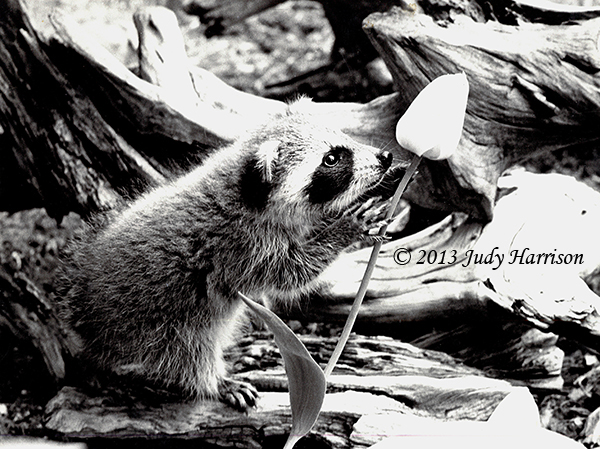
Those are the options for wildlife, particularly in the urban environment which we consider our territory. After all, who built all those roads and buildings with the accompanying infrastructure? People don’t say this in so many words, but that is how many feel towards wildlife in the city – hostile, intolerant and with an us-versus-them attitude.
Read moreCity Living – Wildlife or Vermin
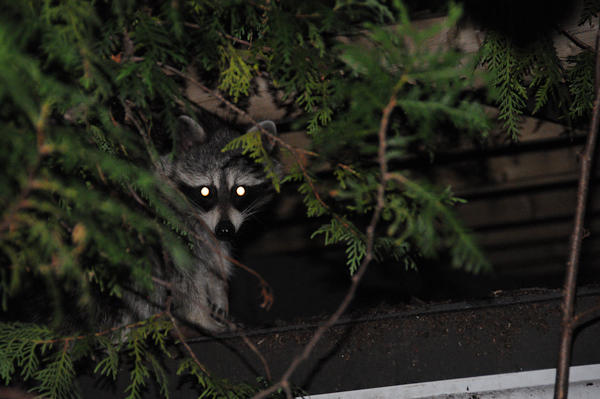 Wildlife (definition): Wild animals and vegetation, especially animals living in a natural, undomesticated state.
Wildlife (definition): Wild animals and vegetation, especially animals living in a natural, undomesticated state.
Well, it is spring and more people are on the move outdoors which usually means more encounters with wildlife, both positive and negative. I had been thinking of urban wildlife lately, given a recent occurrence in which a coyote was shot by Toronto Police and an opinion piece which was published in the local paper: "Time to cull city’s nasty raccoons” – all on the eve of the Biodiversity in the City workshop that I will be attending in two days time.
Read moreA tale of two city yards
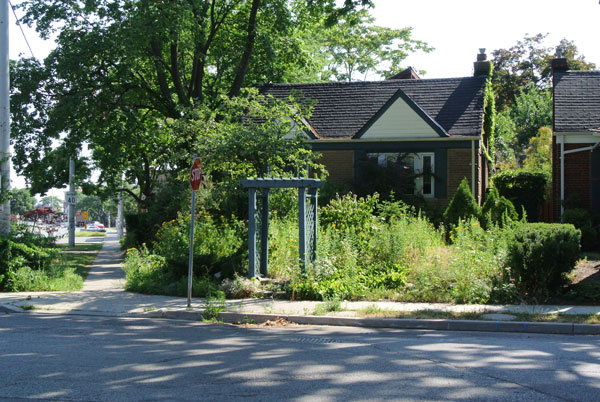 Is this a case of neglect or a naturalized garden?
Is this a case of neglect or a naturalized garden?
In my last post,
Living on the Edge – Boulevard of Broken Dreams, I mentioned some pitfalls with assuming that the front yard was fair game for you to garden at will, knowing that all eyes are on this more publicly accessible area. I urged caution and suggested that you should be at least aware of or familiar with your local bylaws pertaining to vegetation. This post will give you a taste of the scrutiny that residents face when living in the urban realm. What is aesthetically acceptable? What is legally acceptable? In many cases they are synonymous, particularly when residents and bylaw enforcement officers often cannot discern the difference.
Read moreLiving on the Edge – Boulevard of Broken Dreams
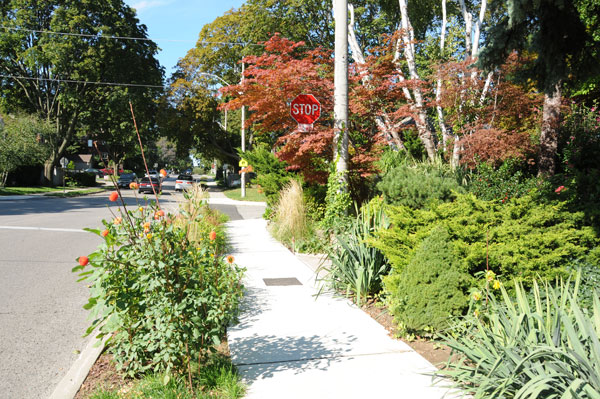 Vegetation living on the boulevard. A better choice would have been native species. Above all, avoid planting goutweed, periwinkle, English ivy, Japanese barberry, etc. These seem to be the choice of gardeners who are avoiding turf but end up planting invasive species.
Vegetation living on the boulevard. A better choice would have been native species. Above all, avoid planting goutweed, periwinkle, English ivy, Japanese barberry, etc. These seem to be the choice of gardeners who are avoiding turf but end up planting invasive species.
Broken dreams? It doesn’t have to be. How adventurous are you? Is planting the municipal-owned strip worth doing or even attempting? Will you incur the wrath of neighbours or bylaw enforcers, if you stray from the norm?
Neglected Niches to Beloved Boulevards
Planting on your own property is a given. But planting on municipal property, the boulevard, the easement or right-of-way that abuts your property and is owned by the city is another matter. Planting in the boulevard is a gray zone. It’s not for everyone; but it should be. If you are feeling timid, should you even try? Why not? Choose the lowest profile, hardiest native species, i.e., tough groundcover and work up from there as your knowledge and confidence grows.
Read moreAn Evergreen State of Mind

I’ve been in a very evergreen state of mind of late. It must be the season, in my northern temperate world of Toronto replete with denuded trees, save for the evergreens. Even then, the bright greens of the growing season have given way to the drabber blush or bronzy hues of foliage in dormancy.
While living in an urban area, we suffer the heat island effect with lots of asphalt, concrete, lights and the crush of human bodies. Yet, we still cling to the romantic notion of the pioneer days of a cold winter with pure white flakes of snow coating the ground. We are lucky if we get anything substantial snow-wise before the end of the year and if it comes, it quickly turns to a murky mush with salt sprays and residues from oily vehicles. Such is the urban existence. One can escape by perhaps gazing out a window to our soul, our garden, taking a walk through the local ravines or a trip further afield to areas outside of the city. A quicker respite can be had through the pages of books.
Read moreCedar Sense Surround
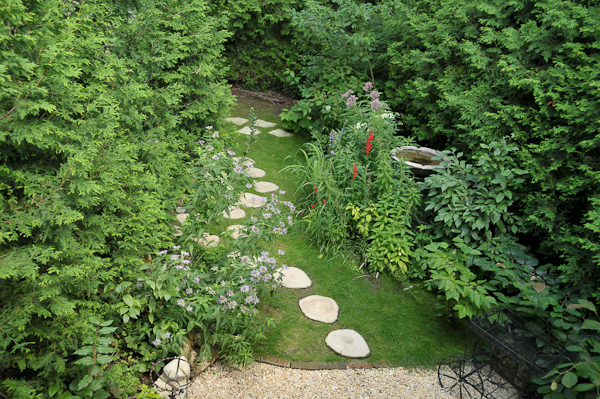 Surrounded by Eastern White Cedar (Thuja occidentalis).
Surrounded by Eastern White Cedar (Thuja occidentalis).
A personal storm. So here I am deeply immersed in city bylaws and misinterpretation, misuse, bureaucratic bungling…déjà vu from almost three years ago when I wrote about it for the
newsletter only for it to come up again as an attack on gardening…
natural gardens … and having to defend while trying to complete a post. The whole thing is coming round on the eve of the first anniversary of losing my father.
Read moreTrespassers Will Be Composted – Scat cat!
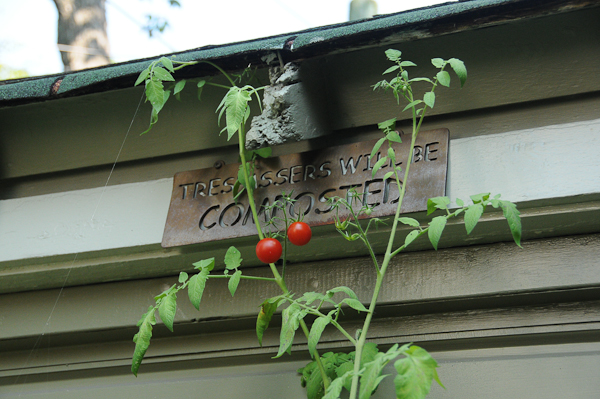 Trespassers will be composted
Trespassers will be composted
I left my
last post alluding to a run in with a neighbour which spurred me to write about threats to having and maintaining a wildlife garden, particular in the urban sphere. I touched on the high rate of mortality due to
window strikes incurred by birds during migration, which is second only to habitat loss, and ways that we, as wildlife gardeners, can avoid being part of the problem.
Read moreIn a FLAP – S.O.B. (Save Our Birds)!
 "Birds provide an accessible connection to the natural world, especially for city dwellers."(FLAP)
"Birds provide an accessible connection to the natural world, especially for city dwellers."(FLAP)
This is not the column that I was supposed to write. I had planned a continuation of
Life on the Edge in the Urban Environment with the evolution of my garden from almost a clean slate or your typical patch of lawn to a wildlife garden full of promise. But with the onset of migration season and a timely run in with a neighbour last week, I was spurred on by a sense of urgency to speak on the subject of preventable bird fatalities. And then I thought…why not highlight the work of an excellent not-for-profit organization that is trying to do something about it? In effect, I’d be killing two birds with one stone. Hey, wait! I really hate the expression, even though for this piece, it seems appropriate, if in a perverted sense.
Read moreLiving on the Edge – Marginal Landscaping in the Urban Environment
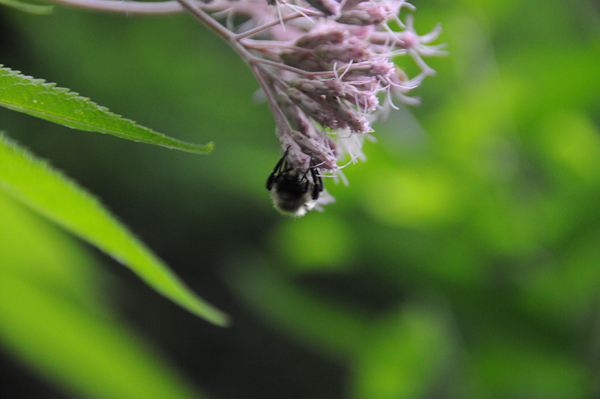 We may choose to live on the edge, but let’s not marginalize our wildlife. Bumblebee on Joe-Pyeweed.
We may choose to live on the edge, but let’s not marginalize our wildlife. Bumblebee on Joe-Pyeweed.
"Out on the edge you see all the kinds of things you can’t see from the center." (Kurt Vonnegut)
Borders come in all forms and scales – national, provincial/state, municipal, individual, and even "rooms” that we may have delineated within our gardens.
In Canada, it’s no coincidence that most of the human population clings to the southern edge where we hug the border with the U.S. The majority (81%) lives in urban areas and most of our largest cities lie along the border. It is more hospitable climate-wise, provides better farmland to sustain human life, and gives close access to our largest trading partner. We share a common border and those near it generally share a common natural history.
Read more

 Typical streetscape weeks after the ice storm.
Typical streetscape weeks after the ice storm.
 This way up. Hackberry (Celtis occidentalis) lives up to its name.
This way up. Hackberry (Celtis occidentalis) lives up to its name.
 Ice-encrusted Virginia creeper (Parthenocissus quinquefolia).
Ice-encrusted Virginia creeper (Parthenocissus quinquefolia).
 U of T - The Back Campus field.
U of T - The Back Campus field.
 Carole Sevilla Brown
Carole Sevilla Brown
 A couple of lawn lost friends: New England aster (Symphyotrichum novae-angliae).
A couple of lawn lost friends: New England aster (Symphyotrichum novae-angliae).
 It's a jungle in there! Full frontal view, Spring 2013.
It's a jungle in there! Full frontal view, Spring 2013.
 Does this look like the face of a bully?
Does this look like the face of a bully?
 Norway maple
Norway maple
 Safe wildlife passage
Safe wildlife passage

 Wildlife (definition): Wild animals and vegetation, especially animals living in a natural, undomesticated state.
Wildlife (definition): Wild animals and vegetation, especially animals living in a natural, undomesticated state.
 Is this a case of neglect or a naturalized garden?
Is this a case of neglect or a naturalized garden?
 Vegetation living on the boulevard. A better choice would have been native species. Above all, avoid planting goutweed, periwinkle, English ivy, Japanese barberry, etc. These seem to be the choice of gardeners who are avoiding turf but end up planting invasive species.
Vegetation living on the boulevard. A better choice would have been native species. Above all, avoid planting goutweed, periwinkle, English ivy, Japanese barberry, etc. These seem to be the choice of gardeners who are avoiding turf but end up planting invasive species.

 Surrounded by Eastern White Cedar (Thuja occidentalis).
Surrounded by Eastern White Cedar (Thuja occidentalis).
 Trespassers will be composted
Trespassers will be composted
 "Birds provide an accessible connection to the natural world, especially for city dwellers."(FLAP)
"Birds provide an accessible connection to the natural world, especially for city dwellers."(FLAP)
 We may choose to live on the edge, but let’s not marginalize our wildlife. Bumblebee on Joe-Pyeweed.
We may choose to live on the edge, but let’s not marginalize our wildlife. Bumblebee on Joe-Pyeweed.
